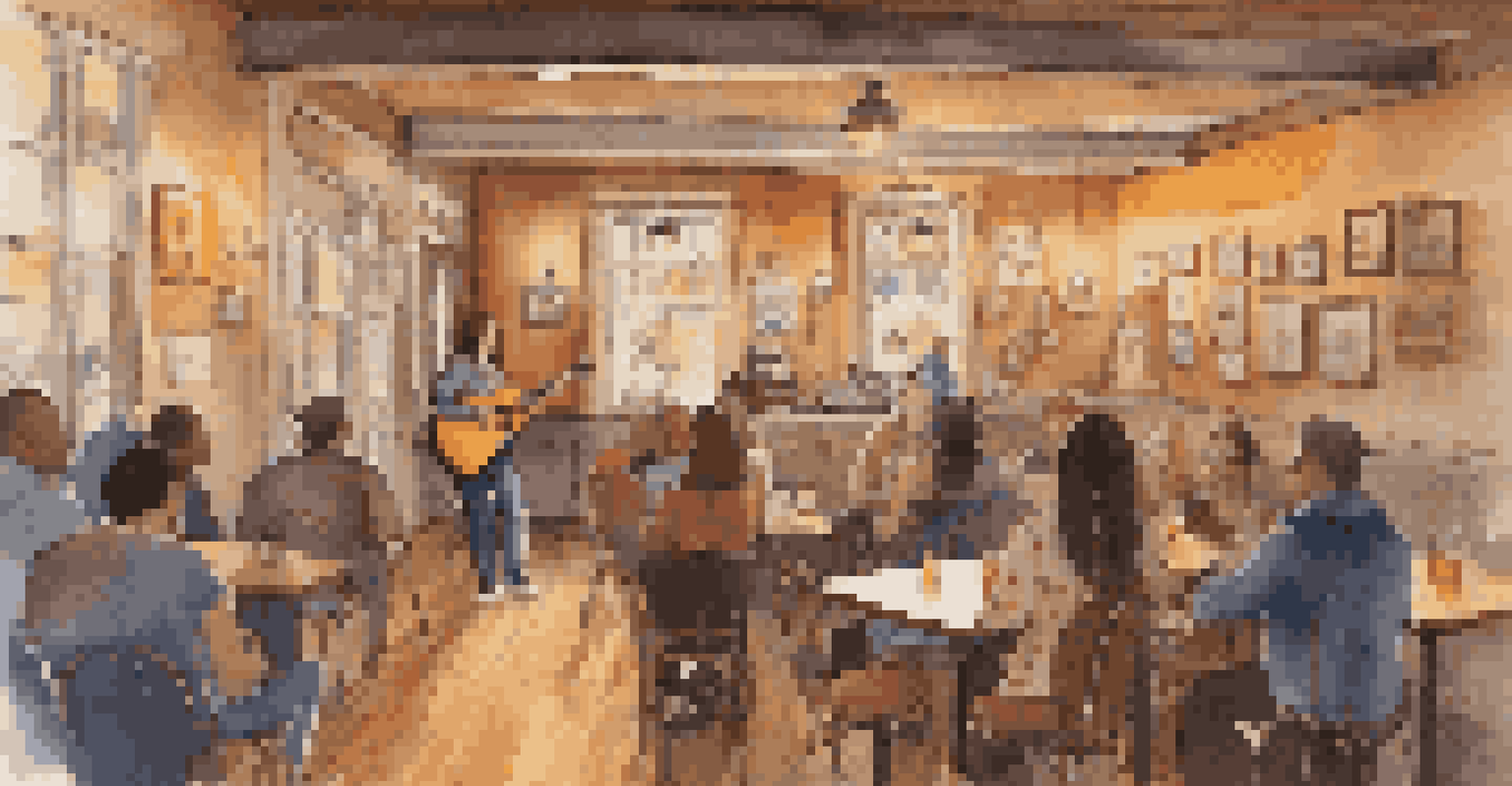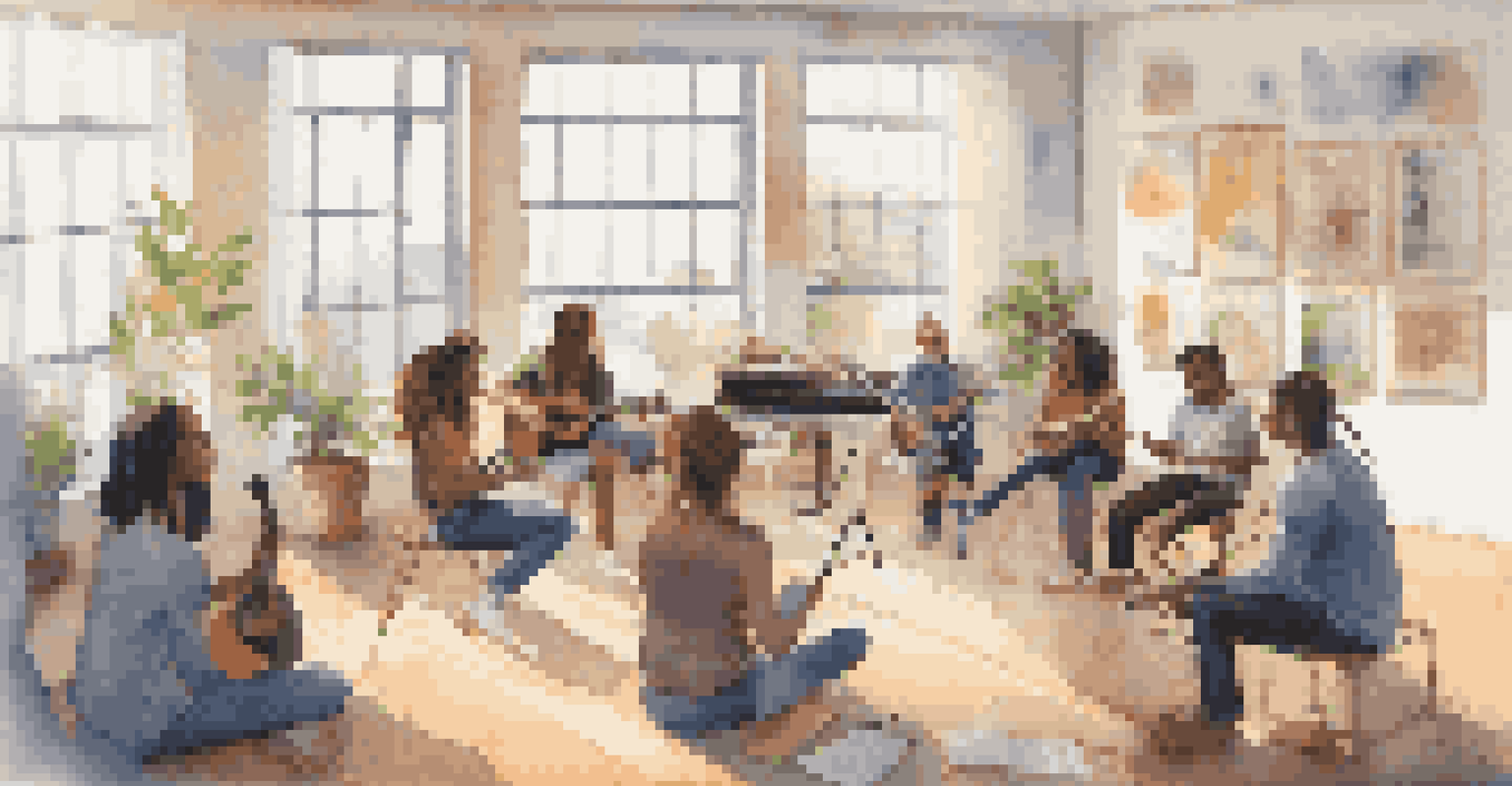Collaborative Music Events: Building Community Through Art

The Power of Music in Community Building
Music has an incredible way of bringing people together. It transcends barriers, allowing individuals from diverse backgrounds to connect and share experiences. When communities unite through music, they create a shared sense of identity and belonging, which is essential for social cohesion.
Music can change the world because it can change people.
Collaborative music events, such as local concerts or jam sessions, are perfect examples of this phenomenon. They provide a platform for artists and enthusiasts to engage with one another, fostering relationships that often extend beyond the event itself. This sense of unity can lead to long-lasting friendships and networks that strengthen community bonds.
Moreover, these events often highlight local talent, giving artists the opportunity to showcase their work. This not only boosts their confidence but also encourages others to explore their own creative potential. In essence, music acts as a catalyst for community development and individual growth.
Types of Collaborative Music Events
There are various formats for collaborative music events, each offering unique experiences. Think of open mic nights, where anyone can step up and share their talent, or community choirs that welcome members of all skill levels. These events are designed to be inclusive, ensuring that everyone feels welcome and valued.

Festivals are another popular format, often featuring multiple artists and genres. They create a vibrant atmosphere filled with energy and excitement, inviting attendees to dance, sing, and celebrate together. Such events can draw large crowds, showcasing the power of music in uniting people.
Music Unites Diverse Communities
Collaborative music events foster connections among individuals from different backgrounds, creating a shared sense of identity and belonging.
Lastly, workshops and collaborative songwriting sessions encourage participants to work together creatively. By sharing ideas and skills, attendees not only learn from one another but also contribute to a collective piece of art. This process fosters collaboration and nurtures a sense of community spirit.
Creating Safe Spaces for Expression
One of the critical aspects of collaborative music events is the creation of safe spaces for expression. These environments encourage participants to share their thoughts, feelings, and creativity without fear of judgment. When individuals feel safe, they are more likely to open up, leading to deeper connections with others.
Without music, life would be a mistake.
Organizers play a vital role in establishing these safe spaces. They set the tone by promoting respect and inclusivity, ensuring that everyone feels comfortable participating. This approach not only enhances the event experience but also fosters a culture of empathy and understanding among attendees.
In turn, these safe spaces can have a profound impact on mental health and well-being. Participants often leave feeling uplifted and inspired, having connected with like-minded individuals who share their passion for music. Such positive outcomes reinforce the importance of community and support.
The Role of Local Artists in Collaborative Events
Local artists are the heartbeat of collaborative music events. They bring their unique perspectives and styles, enriching the overall experience for attendees. By showcasing local talent, these events contribute to a vibrant cultural scene that celebrates the community's diversity.
Moreover, when local artists participate in such events, they often inspire others to pursue their creative passions. This ripple effect can lead to a thriving arts community, where individuals feel motivated to collaborate and innovate. In this way, the power of music extends far beyond the stage.
Local Artists Inspire Creativity
By showcasing local talent, collaborative events not only enrich the cultural scene but also motivate others to explore their own artistic passions.
Additionally, supporting local artists helps maintain the character and identity of a community. As they share their stories through music, they create a narrative that resonates with residents and visitors alike. This fosters pride and ownership within the community, further solidifying the bonds created through collaboration.
Fostering Inclusivity Through Collaboration
Inclusivity is a cornerstone of successful collaborative music events. By welcoming diverse participants, these events create a rich tapestry of sound, perspective, and culture. When everyone has a seat at the table, the resulting synergy can lead to extraordinary artistic expressions.
This inclusivity extends beyond musical genres; it encompasses various ages, backgrounds, and skill levels. Events that prioritize diversity not only enrich the experience for attendees but also challenge societal norms and stereotypes. This can be especially powerful in communities that have faced division or marginalization.
As participants collaborate and learn from one another, they cultivate a greater appreciation for different cultures and viewpoints. This exchange of ideas fosters understanding, empathy, and ultimately, a more harmonious community. Music becomes a unifying force that bridges gaps and inspires solidarity.
Engaging Youth Through Music Events
Collaborative music events can play a crucial role in engaging youth within a community. They provide young people with opportunities to express themselves, develop their skills, and connect with peers. This engagement is essential for fostering creativity and personal growth during formative years.
By participating in music events, youth can explore their interests in a supportive environment. Whether they are singing, playing an instrument, or working on songwriting, these experiences can ignite a lifelong passion for the arts. Additionally, working alongside local artists can serve as mentorship, guiding young individuals on their creative journeys.
Inclusivity Fosters Community Growth
Welcoming diverse participants in music events enhances creativity and understanding, ultimately leading to a more harmonious and resilient community.
Moreover, involving youth in event organization and planning can empower them and give them a sense of ownership. When young people feel they have a voice in their community, they are more likely to stay engaged and contribute positively. This investment in the next generation is vital for creating a thriving and vibrant community.
The Long-Term Impact of Collaborative Music Events
The benefits of collaborative music events extend far beyond the event itself. They leave a lasting impact on the community, fostering relationships, creativity, and a sense of belonging. Over time, these connections contribute to a more resilient and engaged community.
As people come together through music, they build networks that may lead to future collaborations and projects. This ongoing engagement can spark new creative endeavors, further enriching the local arts scene. The relationships formed at these events often evolve, creating a supportive ecosystem for artists and participants alike.

In addition, the sense of community strengthened through music can lead to collective action on social issues. When individuals feel connected, they are more likely to come together to advocate for change and support one another. This ripple effect underscores the profound role that collaborative music events play in shaping vibrant communities.